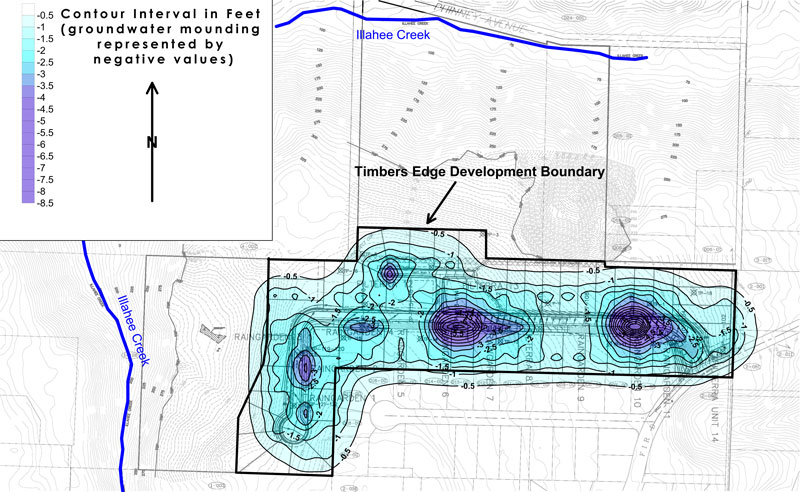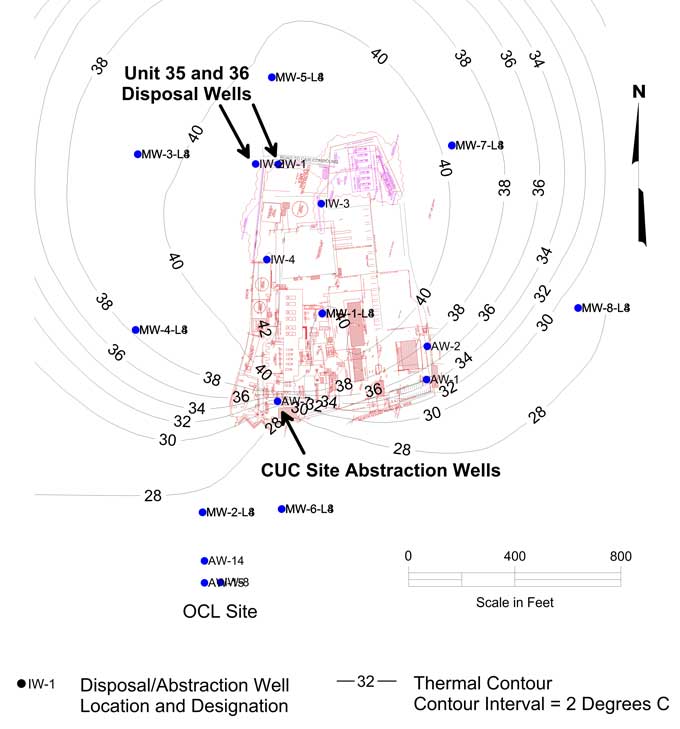Computer Modeling
Computer models provide a method of evaluating the behavior of complex groundwater systems under a wide range of conditions. The model may consist of a simple spreadsheet, or if subsurface conditions and project requirements are complex, a more rigorous numerical model. Our experience with numerous modeling projects allows us to readily determine the level of complexity needed to adequately evaluate groundwater conditions. In general, we have found that a simple model is usually the most efficient and cost-effective, and provides the needed information.
Particle tracking showing distribution of injected treatment compound
In many cases, subsurface information may not support a detailed modeling approach. Instead, a conceptual computer model combined with parametric analyses can help identify data gaps, understand types of data needed to reduce uncertainty, provide a basis for decision making, and evaluate risk to a project early in the process.
Richard has vast experience in numerous analytical and numerical models including MODFLOW, MT3D, MODRET, PATH3D, SUTRA, MOC, STOMP, and SEEP/W. He has efficiently developed and used numerical models on projects ranging from small fuel tank spills to large-scale regional modeling, such as the three-dimensional groundwater flow model that he developed for the Alaskan Way Viaduct Replacement Project for the Washington State Department of Transportation. Richard was an invited lecturer for two sessions on "Computer Modeling" and "Contaminated Sites" for the American Society of Civil Engineers Dewatering Short Course, November 13-14, 2008.
Computer Modeling Project Examples:
Timbers Edge Development Mounding Analysis
Richard Martin Groundwater is providing hydrogeology and infiltration expertise to this proposed approximate 30-acre development in Kitsap County. The goal is to infiltrate 100 percent of stormwater runoff from new impervious surfaces using infiltration trenches, rain gardens, and other infiltration structures. To evaluate the performance of the rain gardens and the effects on nearby steep slopes, we developed a groundwater flow model using MODFLOW. The model was used to simulate infiltration of stormwater runoff for a 100-year, 24-hour peak storm event. A time variant infiltration rate was input to the model based on the result of stormwater hydraulic modeling performed for the project. Parametric analyses were then completed to capture the potential affect of variability and uncertainty of subsurface hydraulic parameters on water table mounding. The results of our modeling indicated that groundwater mounding would not affect the infiltration capacity of the rain gardens and the increase in groundwater levels near the slopes would likely be less than 0.5 feet. Final design is ongoing and construction is anticipated to start in 2013.

Contours of water table mounding below rain gardens
after peak storm event
Washington State Department of Transportation, Alaskan Way Viaduct/Seawall Replacement Project, Seattle, WA
Richard constructed a three-dimensional groundwater flow model of downtown Seattle for the review of each of the five alternative alignments as part of the Environmental Impact Statement (EIS) for Alaskan Way Viaduct/Seawall Replacement project. For preliminary design, Richard evaluated the feasibility of dewatering for a deep cut and cover structure along the waterfront that has been proposed for two of the alternatives. The dewatering evaluation also considered potential impacts for the EIS, including dewatering-induced ground settlements and the potential of contaminant migration during construction. The model was also used to assess potential impacts to groundwater including mounding behind the finished structure, changes in groundwater discharge volumes and locations to Elliott Bay, and potential degradation of groundwater quality. Using the model, Richard completed a detailed evaluation of dewatering requirements for the project, including number, location, and design of dewatering wells and the use of recharge wells for mitigating drawdown of the water table in shallow soil.
Caribbean Utilities Company (CUC), Simulated Groundwater Flow and Heat Transport, Grand Cayman Island
CUC uses diesel engines for power generation and groundwater is used as a coolant for the engines. The preferred means of disposing of the spent cooling water is by reinjection into the underlying karst aquifer system. Richard developed models for the project using MODFLOW for the groundwater flow portion of the model while MT3D was used to simulate heat transport. He used the models for design of the original well field and calibrated the model to field conditions after initiation of the well field. The model was used to assess potential impacts of injection of the heated water on the local aquifer system. The model indicates that local groundwater temperatures may increase as a result of reinjection of the heated water, however, the impacts would be of limited areal extent and would not affect other groundwater users in the area.

Contours of groundwater temperature showing the effect of injecting heated water into the underlying aquifer
